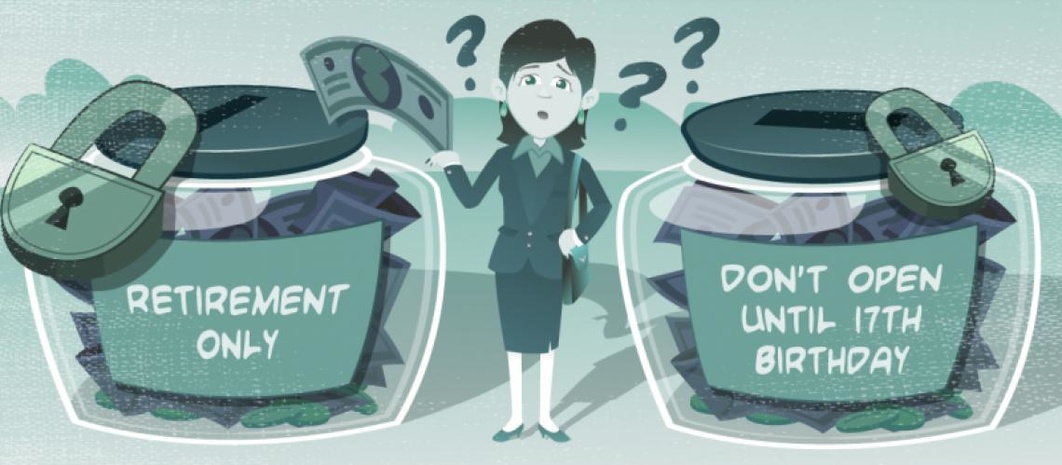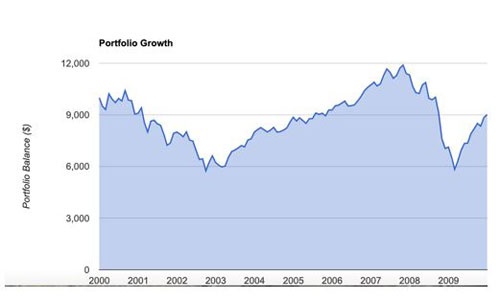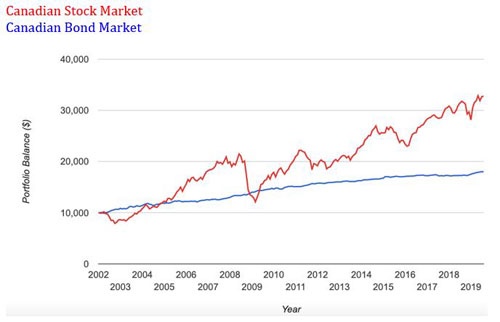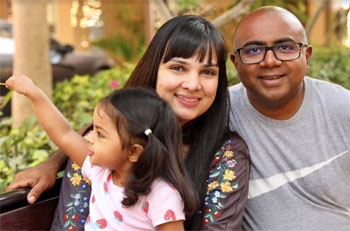
Andrew Hallam
05.09.2019
How Expats Should Invest For Their Children’s Education
_
Krista Plank is a single Canadian woman who’s living in China. She’s raising her six-year old son, Malaya. When she graduated from university, Krista had $50,000 in student loan debt. “I want to avoid that for my son,” she says. That’s why Krista is investing money for Malaya’s education.
If she still lived in Canada, the process would be easy. Krista could open a RESP (Registered Education Savings Plan) in her son’s name. But because Krista lives overseas, she can’t open such an account.

Christa Plank and her six-year old son, Malaya
Photo courtesy of Christa Plank
Plenty of expats face similar dilemmas. They want to save for their children’s education. But they don’t know how.
There are five important elements to remember when saving for a child’s education:
1. Pay low fees
2. Make sure the money is diversified
3. Try to keep the money separate from your retirement proceeds
4. Take less risk with the money as the child grows older
5. Try to limit currency risk
Pay Low Fees
Plenty of financial salespeople prowl expat waters. They might try to invest your child’s education money (and your retirement money!) in a high-cost portfolio. But the more you pay in investment fees, the less money you will make. If anyone tries to sell you an investment, run the other way. Responsible portfolios are bought…they are never sold by expatriate salespeople. So stick to a portfolio of low-cost index funds.
Make Sure The Money Is Diversified
Your children’s education money should be invested in a global, diversified, low-cost portfolio of stock and bond market index funds. Don’t build the portfolio on what you consider to be the “best sector” or the funds that have achieved the best five or ten-year results. After all, chasing past winners will likely cost you plenty.
Try To Keep The Money Separate From Your Retirement Proceeds
Imagine an expat selects a retirement portfolio with 80 percent global stocks and 20 percent bonds. Assume the parent doesn’t separate their own retirement money from money that’s earmarked for their children’s education. Assume the child is 17 years old, and the parent’s account falls 37 percent in a single year. That happened in 2008. It would have turned a $100,000 portfolio (invested 80% in stocks, 20% in bonds) into just $62,888.
If a child were entering college that year, the parent would have needed to sell enough of that portfolio to pay the first year’s fees. In other words, they would have sold large chunks of their portfolio at a huge loss. Unfortunately, they couldn’t write, “Dear College Admissions: Could you please accept my child’s annual tuition payment after the market recovers? We’re not sure when that will be. But we hope you’ll be patient.”
Take Less Risk With The Money As The Child Grows Older
Imagine a 90-year old man. He’s really strong. But his doctor says, “You have just four years to live.” He has enough money for a magical, round-the-world four-year cruise. He has to pay in four equal installments. Should he sell enough of his portfolio to cover the first year’s costs, and then keep the remainder in the stock market until the next bill is due? If you know that stocks can move up and down, that question should answer itself. He shouldn’t keep it invested in the stock market.
Here’s an investment rule of thumb. If you’ll need money (all of it) within a 5-year period, then you shouldn’t keep it in the stock market. Now consider a 17-year old soon-to-be college student. Her money should be invested just like the old man’s. After all, she’ll need all of it for college within a four-year period.
In the table below, I’ve presented guidelines to show how much of a child’s education portfolio should be allocated to stocks and bonds, depending on their age. For example, Krista Plank’s six-year old son should have 60-70 percent of his education portfolio invested in stocks and 30-40 percent invested in bonds. When her son is about 11 years old, Krista should make sure his portfolio has 40-50 percent in stocks, with the remainder in bonds. By the time Malaya is 16 years old, his account should have virtually no exposure to stocks.
How Much Of Your Child’s Education Money
Should Be Invested In Stocks and Bonds?
| Stocks | Bonds | |
|---|---|---|
| Below Age 5 | 80-90% | 10-20% |
| Aged 5-10 | <60-70% | 30-40% |
| Aged 11-15 | 40-50% | 50-60% |
| Aged 16 to College Graduation | 0-10% | 90-100% |
This might look wimpy. After all, stocks beat bonds over long time periods. But over short time periods, anything can happen. When it comes to stocks, ten years is short term. Krista Plank’s six-year old son could be applying for college in about 11 years. And if you think that stocks always rise, check out the 10-years below. If somebody had invested $10,000 in the S&P 500 index of U.S. stocks in January 2000, it would have been worth almost 10 percent less, 10 years later.
Ten Years Isn’t Long-Term In The Stock Market
U.S. Stocks Dropped 9.84%: January 2000-January 2010

portfoliovisualizer.com
That’s why older children should have little exposure to stocks in their education accounts. I back-tested 20 four-year “college periods” starting in 1996. In each case, I assumed the parent had enough money invested to cover 4-year college costs.
Overall, students with 100 percent invested in bonds, as 17 year-olds, would have seen their money last four years. If, on the other hand, their portfolios also contained stocks, the odds of the money lasting four years were dramatically reduced.
For example, if the student’s first year of college was in 2001, and if they had a portfolio invested 70 percent in stocks and 30 percent in bonds, they would have run out of money before the 4 years were up. But if the portfolio were invested 100 percent in bonds it would have lasted 4 years.
Would College Funds Have Lasted 4 Years?
Withdrawing Inflation-Adjusted 25% Per Year*
| College Withdraw Beginning Year | 100% Global Stocks Would The Money Have Lasted 4 Years? | Global Stocks, 30% Global Bonds Would The Money Have Lasted 4 Years? | 100% Global Bonds Would The Money Have Lasted 4 Years? |
|---|---|---|---|
| 1996 | Yes | Yes | Yes |
| 1997 | Yes | Yes | Yes |
| 1998 | No | Yes | Yes |
| 1999 | No | No | Yes |
| 2000 | No | No | Yes |
| 2001 | No | No | Yes |
| 2002 | Yes | Yes | Yes |
| 2003 | Yes | Yes | Yes |
| 2004 | Yes | Yes | Yes |
| 2005 | Yes | Yes | Yes |
| 2006 | No | No | Yes |
| 2007 | No | No | Yes |
| 2008 | No | No | Yes |
| 2009 | Yes | Yes | Yes |
| 2010 | Yes | Yes | Yes |
| 2011 | Yes | Yes | Yes |
| 2012 | Yes | Yes | Yes |
| 2013 | Yes | Yes | Yes |
| 2014 | Yes | Yes | Yes |
| 2015 | Yes | Yes | Yes |
| Success Rate | Success Rate | Success Rate | |
| 65% | 70% | 100% |
Source: portfoliovisualizer.com
*If college costs were deemed to be $100,000 over 4 years, the parent would withdraw $25,000 to pay for the first year in college fees. But college costs aren’t stagnant. In the second year, the parent would likely have to withdraw slightly more than $25,000 because of rising college costs. I based the annual withdrawal increases to match each year’s inflation rate.
Krista Plank has a diversified portfolio of low-cost ETFs for her retirement account. It includes exposure to Canadian stocks, global stocks and Canadian bonds. She could keep her son’s education money in her own account, while still keeping it separate. For example, Krista could buy a Vanguard or iShares all-in-one portfolio of ETFs for her son.
He’s currently six years old, so Krista could select the iShares Core Balanced ETF Portfolio (XBAL) or Vanguard’s Balanced ETF Portfolio (VBAL).
They include 60 percent Canadian and global stocks, with 40 percent invested in Canadian bonds. Vanguard and iShares automatically rebalance their all-in-one portfolios to maintain a constant allocation.
When her son turns 11 years old, Krista could sell the balanced fund and purchase Vanguard’s Conservative ETF Portfolio (VCNS). It has 40 percent invested in Canadian and global stocks. The remaining 60 percent is invested in Canadian bonds.
Children Attending A Canadian University
Portfolios (Funds) Change, Depending On Child’s Age
| Child's Age | Fund Appropriate By Age | These All-In-One Portfolio Funds include… |
|---|---|---|
| Below Age 5 | iShares Core Growth ETF Portfolio (XGRO) or Vanguard's Growth ETF Portfolio (VGRO) | 80% Canadian and Global Stocks 20% Canadian Bonds 80% Canadian and Global Stocks 20% Canadian Bonds |
| Aged 5-10 | iShares Core Balanced ETF Portfolio (XBAL) or Vanguard's Balanced ETF Portfolio (VBAL) | 60% Canadian and Global Stocks 40% Canadian Bonds 60% Canadian and Global Stocks 40% Canadian Bonds |
| Aged 11-15 | Vanguard's Conservative ETF Portfolio (VCNS). * | 40% Canadian and Global Stocks 60% Canadian Bonds |
| Aged 16-Graduation | iShares Core Canadian Short-Term Bond Index (XSB). | 100% Exposure To Canadian bonds |
*As of August 21, 2019, there was no iShares equivalent to Vanguard’s Conservative ETF Portfolio (VCNS)
And when Krista’s son is 16 years old, she could sell Vanguard’s Conservative ETF Portfolio and put the proceeds in a Canadian bond market index, such as the iShares Core Canadian Short-Term Bond Index (XSB). Below, I’ve shown the stability of the Canadian bond market index (in blue) compared to the hair-raising ups and downs of the Canadian stock market index (in red). The bond index (in blue) made money over every 4-year period. But we can’t say the same for Canadian stocks (in red).
January 2001 – July 31, 2019
Stocks Are Volatile, But Bond Index Funds Are Far More Stable

Source: portfoliovisualizer.com
The previously mentioned all-in-one portfolios wouldn’t just work for Krista’s son. They should work well for anyone who wants their children attend a Canadian university. After all, such portfolios would also reduce currency risk.
Try To Limit Currency Risk
When Krista’s tuition bill is due, she’ll have to pay in Canadian dollars. Fortunately, her son’s portfolio will have a strong connection to that currency. After all, Vanguard’s and iShares’ Canadian all-in-one portfolios include a Canadian stock index, a global stock index and a Canadian bond index.
Without such high Canadian dollar exposure, Krista’s son’s portfolio would take larger currency risk. For example, let’s assume it were invested in just two indexes: a global stock index and a global bond index. Assume it didn’t include Canadian stocks or Canadian bonds. As a result, it would have high exposure to global currencies, and almost no exposure to the Canadian dollar. If the Canadian dollar rose strongly against global currencies a few years before her son went to college, Krista could lose a lot of money, in Canadian dollar terms.
For example, in the 10 years from 2003 to 2013, the Canadian dollar increased 37 percent against the U.S. dollar. On average, it gained about 30 percent on most global currencies. If a Canadian parent didn’t include high exposure to the Canadian dollar, she might have to pay far more than she bargained for, if the Canadian dollar rises. And if the Canadian dollar fell instead, the effect would be neutral. Canadian universities, after all, ask for tuition in Canadian dollars.
Similarly, from 2003 to 2013, the Australian dollar increased a lot. That’s why any parent who wants their children to attend an Australian university should consider a diversified portfolio with a lean towards the Aussie dollar. The all-in-one funds below would do the trick.
Children Attending An Australian University
Portfolios (Funds) Change, Depending On Child’s Age
| Child's Age | Fund Appropriate By Age | This fund includes: |
|---|---|---|
| Below Age 5 | Vanguard's Diversified High Growth Index (VDHG) | 90% Australian and Global Stocks 10% Australian Bonds |
| Aged 5-10 | Diversified Growth Index ETF (VDGR) | 70% Australian and Global Stocks 30% Australian Bonds |
| Aged 11-15 | Vanguard Australia's Diversified Balanced Index (VDBA)
or | 50% Australian and Global Stocks 50% Australian Bonds 30% Australian and Global Stocks 70% Australian Bonds |
| Aged 16-Graduation | 1100% Exposure To Australian bonds |
No Matter What Your Nationality, Follow The Same Rules
Your children might not attend university in Canada or Australia. But that doesn’t mean you can’t follow the same rules. For example, 40 year-old Christine Peacock, and her 38 year-old husband, Rohit Jayakaran, have a 2-year old daughter named Olivia. The couple’s retirement portfolio includes 70 percent in Vanguard’s FTSE All-World UCITS ETF (VWRA) and 30 percent in the iShares Global Government Bond Index (IGLA).
They don’t know where Olivia will attend college, so they can’t completely eliminate currency risk. But they can build a diversified, low-cost portfolio that’s distinct from their own.

Christine Peacock, Rohit Jayakaran and their 2-year old daughter named Olivia Photo
courtesy of Christine Peacock
They could put Olivia’s education money in a brokerage account under Christine’s name, while the couple’s retirement portfolio could be in a brokerage account in Rohit’s name. If they don’t want to open another account, they could put Olivia’s education funds in their retirement account, as long as they kept the money separate.
For example, they might use the iShares MSCI World ESG Screened UCITS ETF (SAWD) for Olivia’s stock exposure and the iShares Core Global Bond UCITS ETF (AGGU) for Olivia’s bond allocation. These would be Olivia’s ETFs. As a result, they would rebalance them and increase Olivia’s bond allocation as she grows nearer to college age.
Parents who want their children to attend college in the UK could use a British stock index, a global stock index and a British bond index. They could also open a separate brokerage account or use different ETFs. I’ve provided an example below:
College In The United Kingdom
When Retirement and Education Money Is In The Same Account
| Allocation | Parent's Portfolio | First Child's ETFs | Second Child's ETFs |
|---|---|---|---|
| UK Stocks | iShares FTSE 100 ETF (CUKX) | Vanguard FTSE 100 UCITS ETF (VUKE) | Vanguard FTSE All-World High Dividend Yield UCITS ET(VHYL) |
| Global Stocks | Vanguard FTSE All- World UCITS (VWRL) | iShares MSCI World ESG Screened UCITS ETF (SAWD) | Vanguard's FTSE All- World UCITS ETF (VWRA) |
| UK Bonds | iShares UK Gilts 0-5 yr UCITS ETF | Vanguard UK Gilt ETF (VGOV) | iShares Index Linked Gilts UCITS (INXG)
|
When parents have more than one child within a 2-year age range, they might decide that one of the portfolios would serve two children. But if there’s a broader range in age, the parents might want to differentiate the money, so they could rebalance each portfolio in a fashion that would suit the children’s respective ages.
Parents who want their children to attend college in Europe could do much the same thing, using a European stock index, a global stock index and a European bond index.
College In Europe
When Retirement and Education Money Is In The Same Account
| Allocation | Parent's Portfolio | First Child's ETFs | Second Child's ETFs |
|---|---|---|---|
| European Stocks | iShares Core MSCI Europe (SMEA) | iShares MSCI Europe SRI (IESE) | Vanguard FTSE Developed Europe UCITS (VWCG) |
| Global Stocks | Vanguard FTSE All- World UCITS ETF (VWRA)* | iShares MSCI World SRI (SUSW) | Vanguard's FTSE All- World UCITS ETF (VWRA)* |
| European Bonds | iShares Euro Inflation- Linked Government Bond UCITS ETF (IBCI) | iShares Euro Government Bond 1-3 Year UCITS ETF (CBE3) | iShares Euro Government Bond 3-7 Year UCITS ETF (CBE7) |
*This ETF trades in USD, but that doesn’t make it a U.S. dollar investment. When rebalancing ETFs that are listed in different currencies, convert their values (on paper) into one common currency before physically rebalancing. See Millionaire Expat, pages 287-290. Because European stocks make up a reasonably large portion of the global stock index, go lighter on the European stock index. See Millionaire Expat, pages 324-325.
If you don’t know where you want your children to go to college (or if you want them to attend college in a developing market country) build a college education fund with global exposure, such as what Christine Peacock and Rohit Jayakaran did for their daughter, Olivia. But as soon as you know where your child will be attending university, adjust the portfolio to reflect that currency.
Some people might sweat over the above ETFs. They might ask, “Why did Andrew pick one ETF over another that we see online?” Such people are sweating the small stuff. There’s no perfect ETF, so don’t beat yourself up looking for the Holy Grail. Just raise your children well, save for their education and remember the five important rules:
1. Pay low fees
2. Make sure the money is diversified
3. Try to keep the money separate from your retirement proceeds
4. Take less risk with the money as the child grows older
5. Try to limit currency risk
Andrew Hallam is a Digital Nomad. He’s the author of the bestseller, Millionaire Teacher and Millionaire Expat: How To Build Wealth Living Overseas
Swissquote Bank Europe S.A. accepts no responsibility for the content of this report and makes no warranty as to its accuracy of completeness. This report is not intended to be financial advice, or a recommendation for any investment or investment strategy. The information is prepared for general information only, and as such, the specific needs, investment objectives or financial situation of any particular user have not been taken into consideration. Opinions expressed are those of the author, not Swissquote Bank Europe and Swissquote Bank Europe accepts no liability for any loss caused by the use of this information. This report contains information produced by a third party that has been remunerated by Swissquote Bank Europe.
Please note the value of investments can go down as well as up, and you may not get back all the money that you invest. Past performance is no guarantee of future results.
